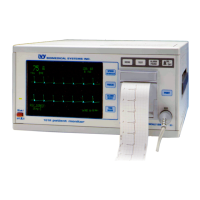THEORY OF OPERATION
Cardiotach
Peak Detector
The peak detector generates a pulse at the peak of each R wave. The time between these pulses is used to compute
the heart rate. See the Peak Detector block diagram below.
4.5 SECOND
TIME-OUT
FROM CPU
FILTER FULL-WAVE SAMPLE THRESHOLD
ECG U26C RECTIFIER AND HOLD RV12
FROM D33, D34 U19, U23D
NOTCH FILTER
PEAK DETECT 7-70 MS
COMPARATOR TEST
U23D, D37, C82 U30A EVENT
TO DIGITAL
CIRCUITS
PACEMAKER
RESET
U20
The ECG signal is picked off by amplifier U26C through a filter made up of R126 and C66 and the components in
the feeback of U24D. This removes the baseline and T waves from the ECG signal. The signal is rectified by
diodes D33, D34 to make sure that the R waves are always positive. The output of the filter and rectifier at U23 Pin
8 is a group of positive pulses for each QRS complex. The first large pulse is the R wave.
For a pulse to be detected, it must exceed a threshold, which is based on the amplitude of the last accepted pulse and
is fine adjusted by potentiometer RV12. Sample and hold circuit U19 with U23D holds the peak level of each
accepted pulse to form the threshold for the next pulse.
When a pulse exceeds the threshold, U23B Pin 7 goes low. When the peak occurs, U23B Pin 7 goes high. The
time between when the signal exceeds the threshold and when the peak occurs must be between 7 and 70 ms for the
pulse to be accepted. The 7 and 70 ms timing pulses are generated by one-shots U30. If the signal is accepted, the
CPU generates a 10 ms EVENT pulse. The leading edge of the EVENT pulse occurs at the peak of the R wave.
This signal goes to the digital circuitry for heart rate computation. Each filtered and rectified QRS complex usually
generates more than one acceptable pulse. Therefore, the EVENT signal usually has two 10 ms pulses for each
heartbeat. A 200 ms blanking in the digital circuitry eliminates all but the first pulse.
A 4.5 second time-out is produced by the CPU. If no acceptable pulses occur for 4.5 seconds, this one-shot times
out and generates a signal that turns on U19. This causes the threshold circuit to acquire a new level.
Whenever a pulse is detected that is less than 7 ms wide, it is assumed to be a pacemaker spike. In this case, U20 is
triggered, generating a 30 ms pulse, which turns on Q22 and Q23 to discharge the filter capacitors and turns on Q31
to inject the last threshold level into the peak detector comparator input.
The Trigger Output at the rear panel connector is derived from the EVENT signal. This output is one 1 ms pulse for
each QRS complex, with the leading edge corresponding to the peak of the R wave. The signal level is -12 V to
Model 101R/NR Service Manual 31

